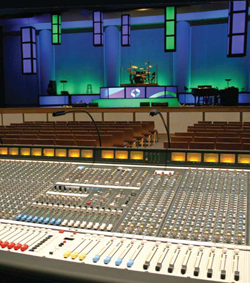Most of the time, we’re dealing with non-professional musicians, limited equipment, and tight deadlines.
While difficult, it’s not impossible to produce good monitor mixes and a good house mix.
In most smaller churches, monitors are mixed from the front of house mixing position.
Typically, smaller churches have 16- to 48-channel consoles that have 6 aux sends.
On these consoles, aux channels 1 through 4 are pre-fader (or can be set that way with a switch), meaning the main house fader has no effect on the level going to that aux.
Some mixers allow aux 5 and 6 to be set pre-fade, but because these are usually used for effects (FX), they’re often hard-wired as post-fade.
Since we want our monitors to be pre-fade if at all possible, a church mix engineer normally has only four mixes available for monitors.
Let’s say we have a band made up of a worship leader, a few vocals, a guitar or two, piano, bass, and drums, and let’s also assume we have a 6-aux board, which means we have four monitor mixes.
With eight or so people on stage, some of them will be sharing mixes. Most of the time, we group similar items together in a monitor mix; bass and drums make up the foundation, so they would share a mix. Guitars and piano carry the melody so they share.
More Me
If possible, I like to break the worship leader’s mix out from the rest of the vocals, and that takes up our other two. This usually works pretty well, but it can lead to what I call “monitor wars.”
Because each instrument is playing in fundamentally the same spectrum, they end up asking for “more me” every time the other player wants “more me.” Turn up the kick for the drummer, and the bass player can’t hear his bass. So he asks for more, which prompts the drummer to need more kick, and so on.
Sometimes it doesn’t hurt to think outside the box and group spectrally different sources. By that I mean, group instruments that aren’t fighting for the same piece of sonic real estate.
Combine the bass and piano, for example, or the guitar and drums. The bass player can focus in on his instrument easier when he’s not fighting for the low end with the drummer.
This won’t always work and may take some experimentation, but it’s worth a shot if you find yourself reading 98 dB (SPL) at front of house with the mains turned off and the band still needs more in their wedges.
Having a wedge at the mix position to be able to hear the monitor mixes is also a good idea. Not all mixers make it easy to do this, but if it’s possible to solo the mix buses and route the output of that solo to a wedge, it’s much easier to get great monitor mixes.
Make sure you set up your gain structure in such a way that the level you hear out of your wedge matches the level the band hears.




















